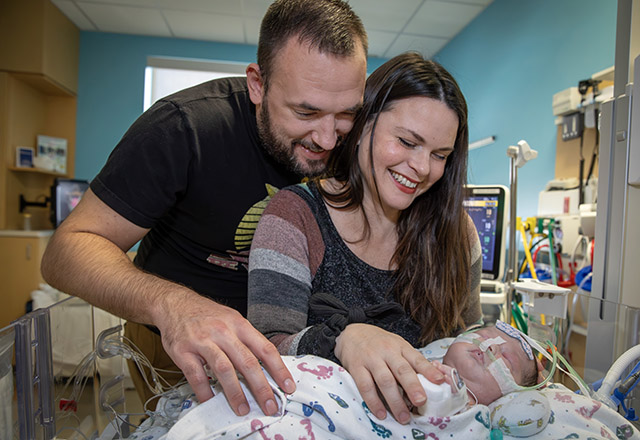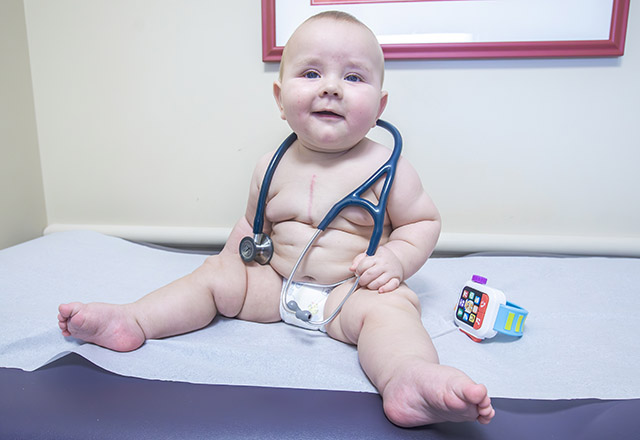Interventional Cardiology
For children with congenital heart defects, cardiac catheterization provides more opportunities for minimally invasive treatment options with reduced recovery times. The interventional cardiology team at Johns Hopkins All Children’s Heart Institute in St. Petersburg, Florida, performs these procedures in our state-of-the-art cardiac catheterization lab.
Cardiac catheterization can be used to both diagnose and treat congenital heart defects, which are conditions that are present at birth. The interventional cardiologist guides a long, thin tube called a catheter through the blood vessels (usually through a tiny incision in the groin area, neck or wrist), using imaging to guide the catheter.
This allows the cardiologist to measure things like blood pressure, oxygen levels and blood flow, to examine the structure of the heart, and to treat a range of congenital heart defects.
Comprehensive Care for Your Child
The interventional team includes physicians, anesthesiologists, registered cardiovascular invasive specialists, advanced care providers, nurse practitioners and nurses who specialize in the care of children with heart defects.
The cardiac catheterization lab is located adjacent to the cardiac operating rooms and to the cardiovascular intensive care unit (CVICU), where physicians with expertise in both cardiac care and critical care medicine care for our patients. The interventional team works closely with our heart surgery and CVICU teams to provide our patients with comprehensive care from diagnosis through follow-up.
The team also specializes In treating adults with congenital heart defects In conjunction with the Adult Congenital Heart Disease (ACHD) program. Adults with congenital heart defects benefit from being monitored and treated by cardiologists with expertise in congenital issues. Learn more about the ACHD program.
Why Choose Johns Hopkins All Children's
Advances in technology allow us to use cardiac catheterization to repair congenital heart defects that would have previously required open heart surgery but can now be repaired using this minimally invasive method. The Johns Hopkins All Children’s interventional cardiology team has special expertise in using the latest devices to treat heart defects in patients of all ages, from premature babies to adults.
The interventional cardiology program is led by James Thompson, M.D., who has performed device closure of over 1,600 defects, such as atrial septal defects (ASD), ventricular septal defects (VSD) and patent foramen ovale (PFO), in the heart. He serves as an industry proctor and teaches other physicians how to close these defects, and is leading research on new devices to close holes in the heart that involve the use of less foreign material.
In children, cardiac catheterization is often used to treat issues in patients who may have already had one or more surgeries to correct a heart defect. Using cardiac catheterization will often reduce the total number of surgeries a patient will need to have throughout his or her life.
Because catheterization procedures involve making a tiny incision to guide the catheter through the blood vessels, recovery time is generally shorter. Children are often able to go home the next day or even the same day as the procedure, and resume normal activity within a few days.
Cardiac Catheterization Procedures We Perform Include:
Balloon angioplasty and stent placement
For children with congenital heart defects, their condition may cause blood vessels (veins or arteries) to become narrow. We use a catheter to insert a very small balloon that inflates to open up the affected blood vessel and improve blood flow. For some children, the inflation of the balloon may not be enough to open the blood vessel, so we will place a small metal tube called a stent inside the narrowed blood vessel to keep it open.
Balloon atrial septostomy
In certain conditions, a balloon atrial septostomy procedure is done in newborns to help improve blood flow before they are able to have surgery to correct their congenital heart defect. The heart has a naturally occurring hole between the upper chambers of the heart. Balloon atrial septostomy is used to enlarge this hole so that blood from both sides of the heart can mix together, so that more oxygen-rich blood travels throughout the baby’s body, in preparation for surgery.
Balloon valvuloplasty
Some congenital heart defects like aortic valve stenosis cause narrowing of the heart valves, which when functioning correctly cause blood to flow through the four chambers of the heart and out to the rest of the body. Balloon valvuloplasty is used to open a narrow heart valve, improving blood flow.
Device closure of patent ductus arteriosus (PDA)
Patent ductus arteriosus (PDA) is a condition in which the artery (the ductus arteriosus) that allows a fetus to send blood directly back to the placenta to pick up oxygen from the mother before birth, fails to close after birth. It typically closes after birth to allow blood flow directly from the heart to the lungs. When this happens, oxygenated blood returns directly to the lungs instead of circulating through the rest of the body, which causes the heart and lungs to work harder and creates difficulty breathing. Using a catheter, a small device is inserted to close the duct.
PDA most often affects babies who are born prematurely. We have special expertise in using the FDA-approved Amplatzer Piccolo Occluder to treat PDA in premature infants. Using a catheter to insert the Piccolo allows us to close it and improve blood flow in babies as small as 1½ pounds without surgery. It is usually done within the first few weeks of life, and evidence shows that babies recover quicker from this procedure compared to previously performed surgical repair for PDA in premature babies. Dr. Thompson is a national leader and early adopter in using the most advanced cardiac catheterization methods and technology to treat PDA in premature infants, and also teaches other physicians how to use this technology.
Device closure of atrial septal defects (ASD)
Children with an atrial septal defect (ASD) have a hole in the heart located in the wall between the two upper chambers. Sometimes the hole may be small enough that it will close on its own and only require monitoring, but larger holes allow too much blood to flow from the left atrium into the right, causing the heart to have to work harder. We use cardiac catheterization to insert a device to close the hole, to improve blood flow and heart function.
Device closure of ventricular septal defects (VSD)
Ventricular septal defects are those in which patients have a hole located in the wall between the two lower chambers of the heart. This allows blood to flow from the left ventricle into the right and directly back into the lungs, which causes the heart and lungs to work harder. Sometimes the hole may be small and close on its own and only require monitoring. Larger holes may be closed with a device inserted with catheterization.
Device closure of patent foramen ovale (PFO)
The foramen ovale is an opening between the two upper chambers of the heart that all unborn babies have. The opening allows blood flow before birth to bypass the lungs, so the heart doesn’t have to work as hard while the baby is developing. The opening usually closes naturally within the first year of life. When it does not close this is called a patent foramen ovale (PFO). Many children with PFO may not experience symptoms or require treatment. In some cases, PFO may cause breathing issues and could be a risk factor for future stroke or heart disease as an adult. We provide device closure using cardiac catheterization for children who require treatment for PFO.
Transcatheter pulmonary valve replacement
In transcatheter pulmonary valve replacement, we use a device called the Melody valve or the Edwards Sapien valve to treat children with congenital heart defects of the pulmonary valve. The pulmonary valve is one of the four valves of the heart that regulates blood flow. Defects of the pulmonary valve interrupt blood flow from the heart to the lungs. Children with these conditions will often initially require one or more surgeries to repair the defect and will need periodic treatment throughout their lives to replace the valves, as they may leak or become obstructed over time. Cardiac catheterization allows us to replace children’s valves as needed without surgery – often leading to fewer surgeries and therefore less stress on the heart – throughout a child’s life.
Contact Us
Learn More Read inspiring stories about our patients.
-
Atrial Septostomy: Alistair’s Story
Before birth, Alistair was diagnosed with a congenital heart defect, requiring specialized care at birth. But when his mother’s water broke, he had to be delivered early at an alternate location. James Thompson, M.D., flew by helicopter to perform a life-saving procedure shortly after his birth, and soon after baby Alistair had a helicopter ride to St. Petersburg for additional care.

-
Interrupted Aortic Arch: David’s Story
David was only a few days old when an undiagnosed heart condition sent him into cardiogenic shock. An echocardiogram showed David had a rare type of congenital heart defect. Learn how the Heart Institute team saved the infant's life and set him on a path to recovery.

-
Big Hope for Tiny Baby with PDA
After baby D’Shay was born nearly four months early, doctors discovered he had a congenital heart defect. He weighed just under 1.6 pounds when interventional cardiologist James Thompson, M.D., performed a specialized procedure that repaired D’Shay’s heart defect and set him on the road to continue progressing and growing.

-
Dr. James Thompson Stays at the Leading Edge of Interventional Cardiology
As one of the nation’s leading interventional cardiologists, James Thompson, M.D., provides expert care to children and families, and trains other physicians on the latest technology. He talks about the medical school presentation that set him on the path, and how he values connecting with patients and families.


